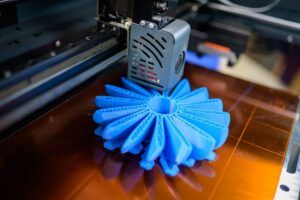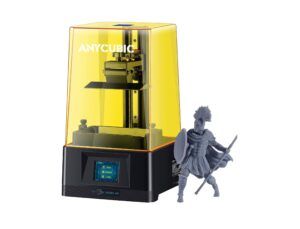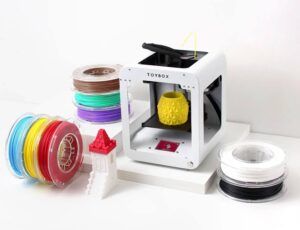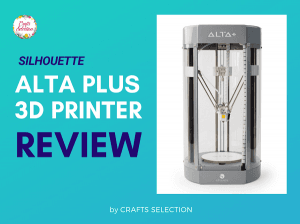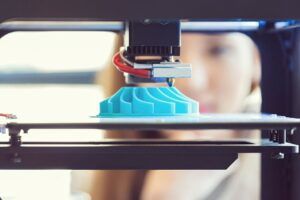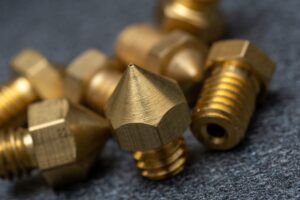3D printing can seem like a formidable activity when you are starting up. Especially if you are a beginner and are only learning how to use a 3D printer. But it doesn’t have to be so challenging and anxiety-inducing as those online 3D printing discussion boards put it out to be. The key is to take it slow, take care of the basics, and not rush into anything.
Another way to do it all right is to listen to the experts. So, here are some actionable tips to use 3D printers for beginners.

Tips to Use 3D Printers for Beginners
To make it easier to navigate this section, we have categorized the tips according to the different phases of beginner 3D printing. Jump to the relevant category to read useful tips, tricks, and even hacks that will get you through your 3D printing activity smoothly.
3D Printer Installation Tips
Use these tips when setting up your printer or doing the actual printing.
- Ensure optimum gap between the printer bed and the nozzle to produce better outputs. The gap is usually recommended by the manufacturer.
- Always maintain the printer bed temperature at recommended levels (for a few minutes) before printing to avoid elephant’s foot or material warping.
- Use glass, Kapton tape, or polyetherimide (PEI) sheets as bed material for a glossy finish. If you’re looking for a matte finish, opt for polycarbonate sheets as bed material.
- To get more refined 3D prints, change the slicer setting to ‘fine’. If you don’t use a slicer, consider setting it up for more flexibility while printing.
- Use a dusting sponge to remove strings and lint from your filament materials before setting it up on the printer.
- Calibrate your 3D printer using a digital caliper. Measure any of your recent creations and verify if the dimensions match your inputs. If they don’t, it’s time to update the settings of your 3D printer.
- Consider free and open-source 3D models for your experiments instead of spending more money. Thingiverse and Thangs have great collections.
Tips for 3D Printer Maintenance/Cleaning


Even a beginner 3D printer needs regular maintenance so that it runs for years without giving you any trouble. Planned or preventive, period maintenance cannot be compromised. Here are some actionable tips to help extend the lifespan of your 3D printer.
- Use acetone or mild alcohol solution to wipe and clean your printer bed. Different materials may demand different cleaning processes. Consult your printer’s instruction manual for more information.
- If you print regularly, assign a day of the month for a planned 3D printer inspection.
- If you are a prolific 3D printer, consider creating a maintenance toolbox containing a dusting brush, lubricant, rubbing alcohol or IPA, a clean cloth, a small screwdriver, a wrench, and pliers.
- Do not use WD-40 as a lubricant on your FDM 3D printer. Instead, look for the manufacturer-recommended lubricant or opt for white lithium grease or liquid silicone.
- When cleaning your 3D printer’s nozzle, using a wire brush can help remove the leftover materials. However, make sure that you turn the printer on and then turn it off after the nozzle has heated up before brushing. This is to avoid shorting and frying your printer’s motherboard.
- Check for and upgrade your printer’s firmware (and slicer) every two months. Consider the upgrade components to decide if you should update at that point or not as upgrading can be a time-consuming process.
- If your 3D printer is placed in an area that is exposed to a lot of dust, consider buying a dust filter. You only need to replace the sponge in the filter periodically, which will ultimately increase the longevity of your printer.
3D Printer Material Storage Tips
Use these tips to take care and prolong the life of your filaments.
- Most filaments such as nylon are hygroscopic in nature, meaning they absorb moisture. This absorption can lead to an unfinished, rough look of your printed output. A good way to prevent this is to store your filaments like PLA wound in spools in air-tight plastic boxes.
- Put desiccants such as silica gel packets in your filament storage containers to further prevent moisture absorption.
- If you’re in a hurry and want your filament to be dry, consider heating it in an oven at the lowest temperature possible.
3D Printer Safety Tips
Even when it comes to 3D printers for beginners, you should put safety first. Here are a few tips in that regard.
- Always wear gloves while handling 3D printers (especially when they are switched on) to avoid burning your hands and fingers. FDM printer beds are extremely hot and can cause scalding.
- Buy a 3D printer glass enclosure to prevent accidental burns.
- When buying an entry-level 3D printer, ensure that the plug has an earthing point (3-point system).
- Fireproof your 3D printer work area. Remove flammable objects like oil, paper, dry craft materials, etc.
- If you use support structures while 3D printing, remove and store them away after printing.
- Always 3D print in a ventilated area.
- Store your 3D printer covered and in a safe place, away from children.
General 3D Printing Best Practices


This is a list of general tips that should always be on the back of your mind. Attempt to make them a part of your 3D printing process as it will both save you time and help extract maximum utility from your 3D printer.
- Take some time out to read your 3D printer’s instruction manual carefully and in full before operating the machine.
- As you start up, consider a learning curve of four to six months before you take up individual projects. Start your 3D printing journey with small and easy designs like a 10-millimeter cube.
- When you finally decide to print a bigger creation, break it down into smaller components. The key to a well-done 3D printing project is to break down a big object into multiple pieces and then blend/join them together. For example, if you are building a small cap for a LEGO character, try to divide it into two parts: a hemisphere and a flat slit.
- Remember the 0.25-millimeter rule, which means considering a 0.25 margin between objects to ensure a smoother fit. For example, if you plan to fit a cylinder inside a solid block, make sure the cavity on the block has an additional margin of 0.25 millimeters in addition to the diameter of the cylinder.
- Use isopropyl alcohol (IPA) or any rubbing alcohol to wipe the printer bed before performing a print. This will remove all residue dirt and dust traces from the bed and help the filament stick on it easily. 91% IPA is recommended for 3D printers.
- Invest in spare nozzles to prepare for emergencies. Nozzles can be delicate and they can wear down easily, so having a pair of spares can be helpful.
- Avoid conditioning or oiling your filament with the hope of smoother printing. It is best to leave a filament alone. As long as it is not exposed to moisture, it is good to use as is.
- As you master 3D printing, consider learning Computer Aided Design (CAD) software. Several free courses based on free software are available on the web today.
- Try out different types of filament materials to get better outputs.
Conclusion
We get it. These tips make 3D printing look all the more complex and filled with challenges. But they are only supposed to ease you into the learning curve that’s important for 3D printing.
One thing that we all know is that 3D printing is nothing like 2D printing. And with a complex product like this, it is always better to be informed and cautious. We hope these tips to use a 3D printer will help you in the long run.
Have a solid hack to help fellow beginner 3D printers? Let us know in the comments below.
